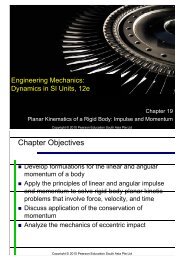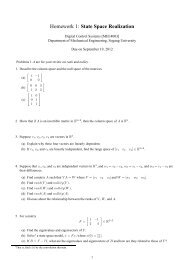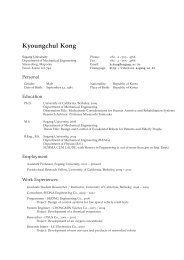Digital Control Systems [MEE 4003] - Kckong.info
Digital Control Systems [MEE 4003] - Kckong.info
Digital Control Systems [MEE 4003] - Kckong.info
You also want an ePaper? Increase the reach of your titles
YUMPU automatically turns print PDFs into web optimized ePapers that Google loves.
2.2. LAPLACE TRANSFORMS AND TRANSFER FUNCTIONS 31<br />
[Example 2-10] Suppose that you adjusted the desired temperature of a room by−4 ◦ C<br />
at t = 0. By controlling an air-conditioner, the room temperature was changed by<br />
y(t) = −4 + 4e −3t . What is the transfer function of the room equipped with the airconditioner<br />
The transfer function is defined by the relationship between the input signal and<br />
the output signal, i.e.<br />
G(s) = Y(s)<br />
U(s) = L{−4+4e−3t }<br />
L{−4}<br />
= −4 s + 4<br />
s+3<br />
− 4 s<br />
= 3<br />
s+3<br />
whereG(s) is the transfer function of the room equipped with the air-conditioner.<br />
[Example 2-11] Suppose that a linear continuous system follows the equation of motion<br />
as<br />
ÿ +2ζω 0 ẏ +ω 2 0 y = K 0u(t)<br />
where the initial conditions are all zeros.<br />
The transfer function is obtained by taking the Laplace transform of the both<br />
sides of the equation, i.e.<br />
L{ÿ +2ζω 0 ẏ +ω 2 0y} = L{K 0 u(t)}<br />
s 2 Y(s)+2ζω 0 sY(s)+ω 2 0 Y(s) = K 0U(s)<br />
Thus, rearranging the equation above, the transfer function is obtained:<br />
G(s) = Y(s)<br />
U(s) = K 0<br />
s 2 +2ζω 0 s+ω 2 0<br />
2.2.4 Relationship between state space models and transfer functions<br />
Conversion from state space to transfer function<br />
Consider a state space model:<br />
ẋ = Fx+Gu<br />
y = Hx+Ju<br />
<strong>Digital</strong> <strong>Control</strong> <strong>Systems</strong>, Sogang University<br />
Kyoungchul Kong


![Digital Control Systems [MEE 4003] - Kckong.info](https://img.yumpu.com/32606446/32/500x640/digital-control-systems-mee-4003-kckonginfo.jpg)
![Digital Control Systems [MEE 4003] - Kckong.info](https://img.yumpu.com/40221932/1/184x260/digital-control-systems-mee-4003-kckonginfo.jpg?quality=85)


